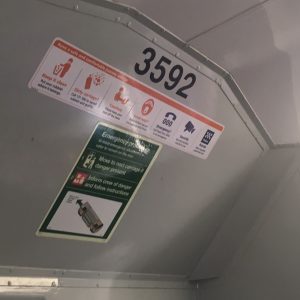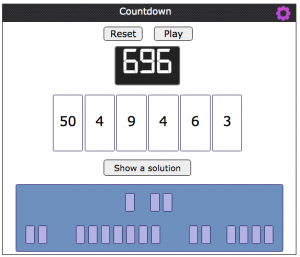If you live in Sydney and catch the train, then there’s a good chance you’ve played the Train Carriage Numbers game. The rules are easy but sometimes finding a solution is hard! A good game has few rules, and limitless possibilities, and this fits the bill. The game was brought back to my attention when I was on the train on Thursday. Three young adults were sitting on the other side of the train and I overheard one of them point out the train carriage number, explain the game to his friends, who all then joined in trying to work out an answer. It was sheer delight as a mathematics teacher to see maths incidentally being enjoyed in public. I even had a little giggle to myself!
How to play
The game is pretty straight forward. All train carriages have numbers (sometimes proceeded by a letter), using these 4 numbers, and the four basic operations, try to make a total of 10. You can play two ways; one, you have to use the digits in the order they are presented, or two, use the digits in any order.
For example, for the numbers here 3592, if I play any order I can do:
9 – 5 + (3 x 2) = 10
It’s a great game and easy to play with your children next time you catch the train, or maybe play on the bus or ferry. You can obviously also add and change the rules depending on the age and ability of your child. You can increase the options by including the use of negative numbers, factorials, square roots or exponents. It also could be used in class, as there is one burning ‘wondering’ question: “Does it work for all carriage numbers?” This is explored in Matthew Egan’s blog where he hypothesises that all carriage numbers can be arrange to equal 10. What a great mathematics investigation for a primary or junior secondary class to work on.
Using the Train Carriage Number Problem in the classroom
If playing the game in the classroom, there are a number of ways it could be utilised, and the investigation supported. You can simply have a new problem up on the board each day or on a Monday morning, students know when they enter the class to expect a new challenge and off they go. It’s a great way to begin the day and get students’ working mathematically processes engaged. You could create a mathematics investigation wall and add up an image for the week, students can then take the challenge when they want, adding up new and different solutions as the week progresses. Or better still, place it on the wall in the corridor where passing students and teachers can also have a go. This idea of building knowledge collectively is also used by Pam Harris @pwharris and her Math Strategy Chat on twitter (#MathStratChat) I highly recommend participating in Pam’s weekly challenge.
To enable all students to participate in the game you can also provide students with scaffolds to create a low floor for the task. Provide students with numbers cards, as well as operation cards, so they can move the numbers around as they problem-solve what number sentences might work. You could also provide ten frames, unifix cubes, grid paper, empty number lines or counters to help represent the count. Drawing diagrams as you model a possible solution could also be of benefit to some students, seeing a visual way of solving the task.
Which ever way to choose to use the game. It’s an easy way to encourage discourse around mental strategies for solving tasks, building skills in perseverance, and can easily be shared with parents and carers as something to do at home to build number knowledge and make connections across operations. You can also see how others have solved different train carriage numbers via the twitter hashtag #Cityrail10 (I do give a language warning though! So maybe look for a specific tweet before showing children/students the whole twitter feed). There’s also a google play app called 10up Number Game.
If this type of number game sounds like fun, you can also try out nrich‘s Countdown game which is excellent (I’ve mapped all of the nrich games/ tasks to the Australian Curriculum and NSW syllabuses, see our resources site for these docs). It’s based on number game from the UK show Countdown, which Australia adapted as Letters and Numbers with the amazing Lily Serna @SernaLily.
Well I hope this has inspired you to do some maths on the train. If you are reading this blog on the train, maybe look up, find the numbers, and have a go! Good luck!







